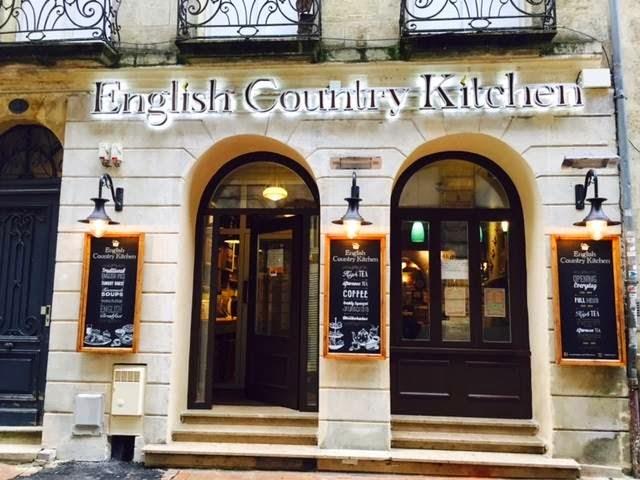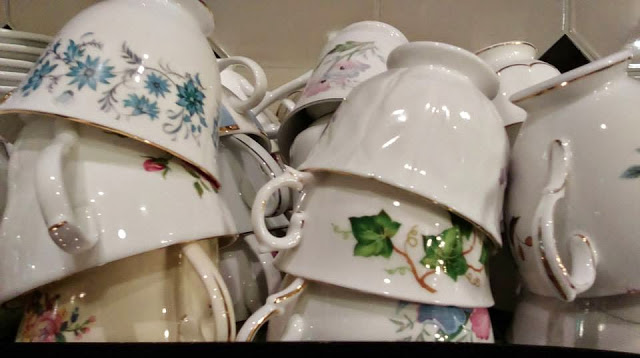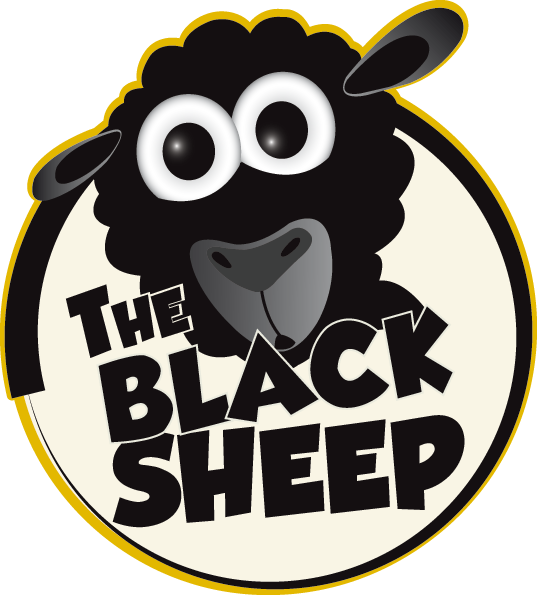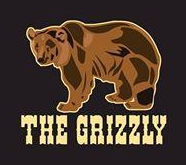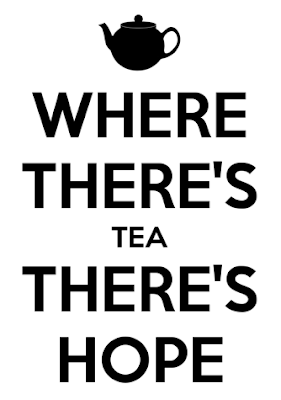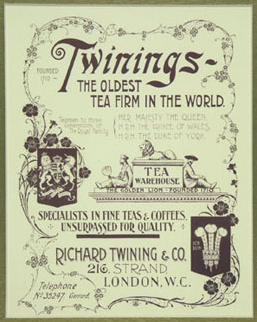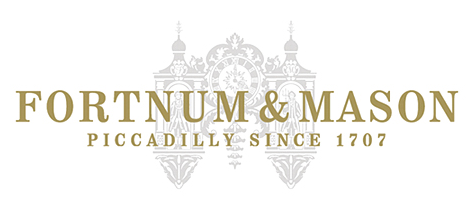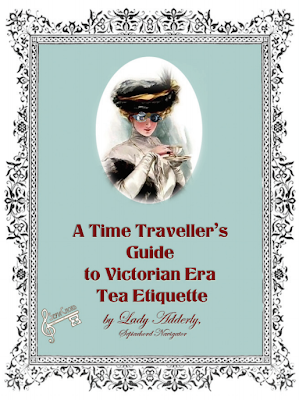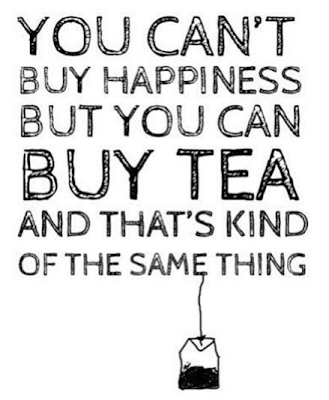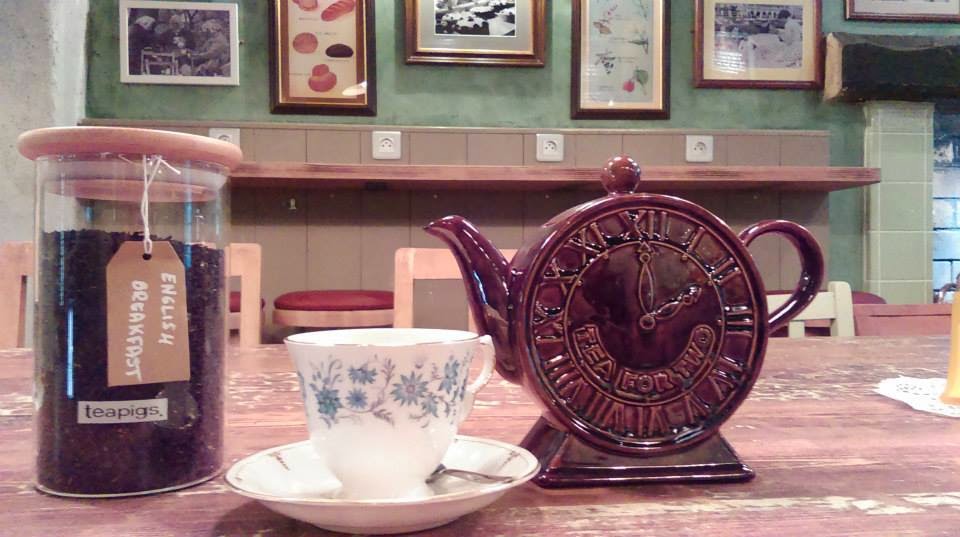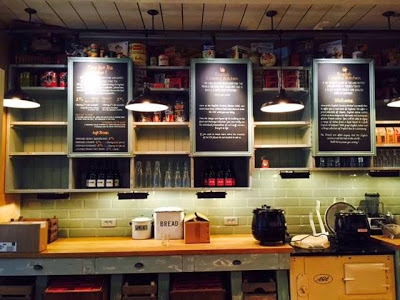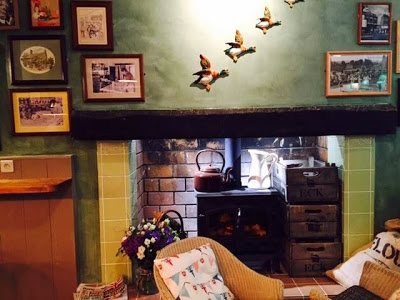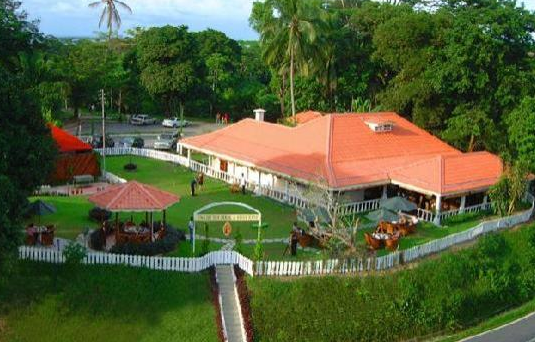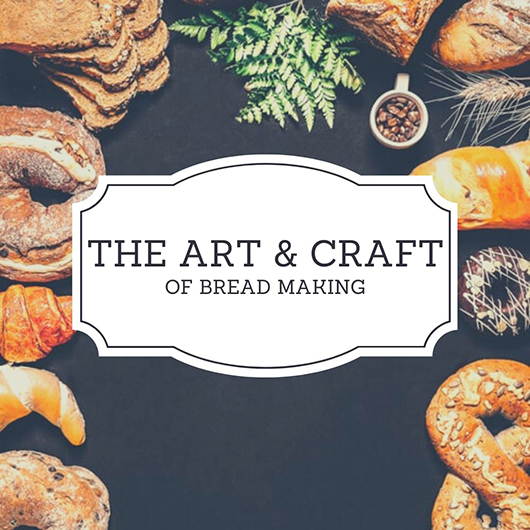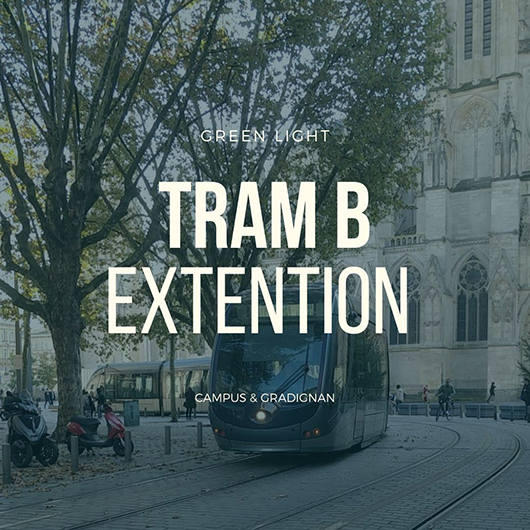
Bordeaux Expat Interview – Will Maley
23/01/2015
“At Last We Fly” – at Espace Mably in Bordeaux
07/03/2015Bringing a touch of elegance and stylish finesse to the Bordeaux brunch scene, the English Country Kitchen has recently opened its doors.
Tucked conveniently behind the UGC Gambetta (Rue Castelnau d’Auros/next to the Sherlock) the ECK teahouse is the perfect venue for a chilled afternoon tea and to indulge in a spot of English tiffin. Bordeaux Expats headed down there to see what they had on offer (and to grab a cheeky interview) and ended up being treated to a feast of biblical proportions…
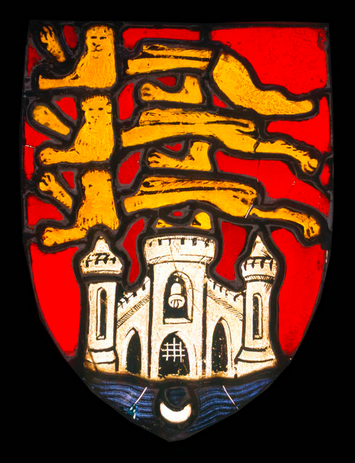 |
| 3 lions and 300 years of English Bordeaux |
English Bordeaux
Bordeaux already has a tremendous amount to offer the hardy English expat who has courageously ventured on to the hostile French soil that was once a colony. It is a little known fact that the capital of Aquitaine has the highest number of expat style pubs per capita in the world. With around 25 establishments brandishing themselves as English or Irish pubs in a city of 245 000 people, there are 9800 people for every pub – which ironically is the exact number of punters who hit the bar at last-orders in my local back home.
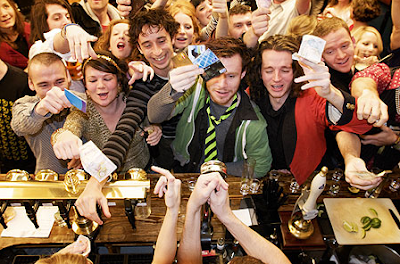 |
| Being English is thirsty business |
BExpats attempted to write about the city beer scene and review all the pubs in a blog a couple of years ago – one bloke has even gone to the trouble of taking photos of them all for another Bordeaux expat blogsite called ‘Drinking it all in‘ – good work mate… Over the past 2 years, the local beer landscape has evolved even further and there has been a whole new wave of varied drinking venues and booze outlets – including some of the following:
- The Ramblin’ Man (by the Pont de Pierre tram stop)
- The Grizzly Canadian theme pub (Place Victoire)
- The DNA pop-up pub (just off Place Fernand Lafargue and part of the ongoing Charles Wells conquest of Bordeaux!)
- Casey’s – just up the road from the ECK on 24, rue Castelnau d’Auros – the sister pub of the City (Arsenal) bar on Rue Palais Galien
- The Black Sheep Gaelic ale house (St Michel on the quai)
- The Melting Pub, 11 Rue Huguerie – “Drink Cheaper, Party Harder” (quiz night and Erasmus student carnage since November last year…)
- The Bordeaux beer shop which also had a BE blog posting (St Michel)
- Sweeney Todd’s has draught new beers on tap – Belhaven Craft Pilsner, Double Hop Monster (7.2% IPA), Belhaven Black and Abbot Ale..!
- As does the HOP and HMS Victory – Adnams Ghostship/Broadside
- The Cave des Moines liquor store (Cours Victor Hugo and the reopening of the nearby bar after 6 months closure for ‘tappage nocturne’)
- Le Comptoire (with its extensive world beer section – opposite the Cock and Bull)
- The Centre de Brassotherapie Bordeaux branch (5 mins walk from the Berges de Garonne tram stop – they also have a stand at the Christmas market every year..)
- The V&B expansion with new off-license/bars in Merignac and Bordeaux Lac
And…
- Gasconha locally brewed beer which has spread to a remarkable 118 city drinking haunts
With the plethora of pubs, the average Expat is never short of nocturnal drinking holes to quench their thirst while watching a match or place to indulge in a full English breakfast/Sunday roast for the morning after. With the Bordeaux Anglo Saxon beer world safely covered (there is also a chippy BTW..!) it was about time someone focused on the other proud British tradition – partaking of cream tea, cake and intelligent conversation in the afternoon…
A brief history of tea…
“In nothing is the English genius for domesticity more notably declared than in the institution of this festival—almost one may call it so—of afternoon tea. Beneath simple roofs, the hour of tea has something in it of sacred; for it marks the end of domestic work and worry, the beginning of restful, sociable evening. The mere chink of cups and saucers tunes the mind to happy repose.” ~ George Gissing, The Private Papers of Henry Ryecroft, 1903
The majestic English cuppa is one of the founding pillars of British culture and has been a benchmark for civilised sophistication for over 300 years. Stretching back to the 17th century with imports from China (later transplanted to British India/Sri Lanka/Kenya etc.), tea was originally seen as a drink for the fashionably rich. Accompanied by China porcelain imports (swiftly duplicated by English manufacturers) tea roomsstarted to spring up all over the UK with London as the epicentre. As well as serving as an icon for social prestige it was also praised for its various health benefits. Tea gardens and Tea parties became all the rage and the exotic beverage became a must for the aspiring upper classes.
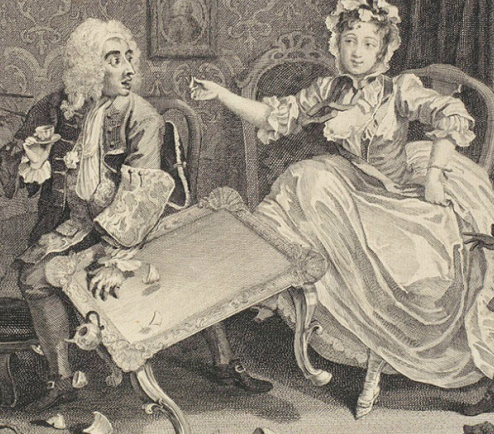 |
| 18th century detractors from tea claimed that it could turn women into whores… |
The first known tea room was opened by Thomas Twining in 1706, which is still open today at 216 on the Strand. Appointed by HM The Queen as a Royal Warrant holder, the logo was created in 1787 and is still in use. The nearby Fortnum and Mason dating from the same era has a long history as a tea vendor – they now offer a superb afternoon tea served on the top floor.
There is also a long tradition of tea rooms within London hotels, for example, at Brown’s Hotel at 33 Albemarle Street, which has been serving tea in its tea room for over 170 years. The Ritz on 150, Piccadilly opened in 1903 and remains one of the most well known and exclusive locations for afternoon tea – with all the trimmings it’s a bargain at £47pp or £59 for a champagne afternoon tea… Other places to try out when you win the lottery and happen to be in London are the Orangery@Kensington Palace, Claridge’s and the Dorchester in Mayfair (around £60pp) and the Lanesborough on Hyde Park Corner (reopening in spring 2015).
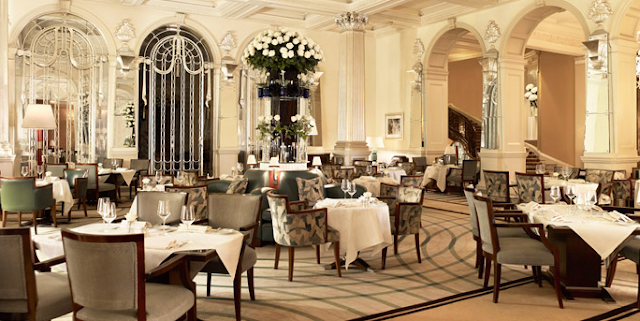 |
| The Claridge’s tea room, no comment |
The Rare Tea company also offers afternoon tea at a snip for £150pp…Here is the Torygraph’s link for the best afternoon teas in the capital:
http://www.telegraph.co.uk/travel/destinations/europe/uk/london/9124793/Londons-ten-best-afternoon-teas.html
http://www.telegraph.co.uk/travel/destinations/europe/uk/london/9124793/Londons-ten-best-afternoon-teas.html
In the 18th century and in the true bourgeois spirit, taking tea was developed into a veritable art form with specific rules for etiquette. Here is for a brief tutorial from the English Cream Tea company on the most polite way to take your tea and the Victorian time-traveler’s guide is here…
A large number of teahouses appeared (Whittard of Chelsea opened in 1886) and tea was fiercely haggled over at the central tea auction near Leadenhall market. The East India Companydominated the market for over 250 years until the 1870’s and oppressive and stringent taxation on tea was one of catalysts of the American Revolution (with the Boston tea party…)
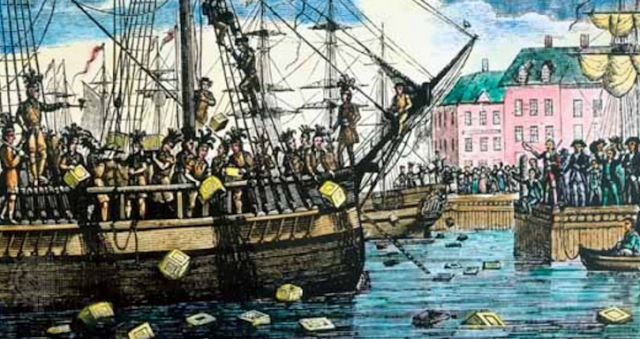 |
| Anti-English revolutionaries spoiling a good cuppa |
“There are few hours in life more agreeable than the hour devoted to the ceremony known as afternoon tea.” – Henry James
By the 19th century tea drinking had entered popular culture playing a major part in the industrial revolution with the introduction of ‘tea time’ being used to increase the number of hours employees worked, as well as alleviating various illnesses which accompanied mass urbanisation. The ‘Brown Betty‘ originating in Staffordshire became commonplace in every Victorian home and was firmly established in Queen Victoria’s court.
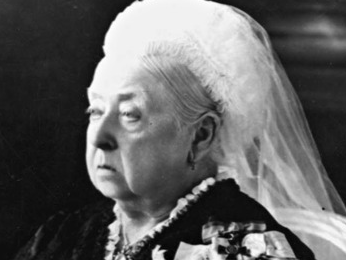 |
| Queen Victoria pulling her ‘tea’ face… |
“If you are cold, tea will warm you;
if you are too heated, it will cool you;
If you are depressed, it will cheer you;
If you are excited, it will calm you.”
― William Ewart Gladstone
if you are too heated, it will cool you;
If you are depressed, it will cheer you;
If you are excited, it will calm you.”
― William Ewart Gladstone
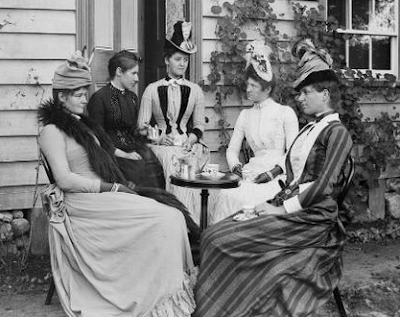 |
| Victorian woman bravely unaccompanied by men |
The working classes originally had access to tea (as well as various spices used to make food palatable) thanks to the vast smuggling network that spread across the UK to undermine the highly taxed and overpriced monopolies held by the trading companies.
Quick fact: From 1801-1911 the population of Britain quadrupled, and the amount of tea drank grew 12 fold…
Indeed there was extensive tea-snobbery with debates over whether or not the lower classes should have had access to tea at all..! Luckily the beverage became associated with the 19th century Methodist church-driven ‘Temperance movement‘ and non-alcoholic beverages such as tea began to be sold at pubs and inns as well as tea tax being slashed (in 1785) to halt illegal imports. With the rise of the British empire, venture capitalists spotted a gap in the market and founded tea plantations throughout the colonies which flooded the market. Informal tea rooms were popular all over the UK especially with women who were able to meet and chat in a welcome and respectable environment without the need to be accompanied by a man…
Despite the widespread popularity of tea houses, the drink was mainly consumed at home and by all levels of society (despite concerns over tea ‘addiction‘!). With extended work shifts, high tea (late afternoon) began to replace lunch as the main meal of the day and the evening meal is still referred to as ‘Tea‘ in various parts of the UK (i.e. up North). With the idea of ‘warding off hunger between luncheon and dinner’, high tea or tea time could consist of anything from biscuits (for dunking), muffins/crumpets/pikelets, Battenberg cake/Victoria sponge and cucumber/smoked salmon sandwiches to full blown ‘cream tea‘ with scones, clotted cream and jam.
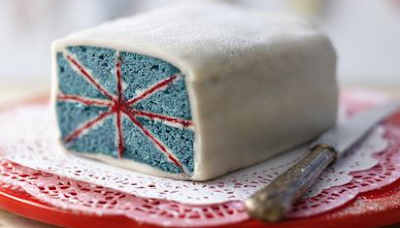 |
| Union Jack Battenburgh cake |
The mass popularity of the boiled beverage was shown by the actions of the UK government during both the wars to maintain tea supplies. Tea was immediately placed under rationing in WW2 and all tea storage sites were moved to secure locations outside London to guarantee stock levels. During the 40’s, the ration of tea was apparently enough to provide everyone with around 3-4 weak cups per day. There are also accounts of US/Canadian soldiers being amazed at the British tommy’s requirement for regular tea and smoking breaks before they would actually do any fighting.
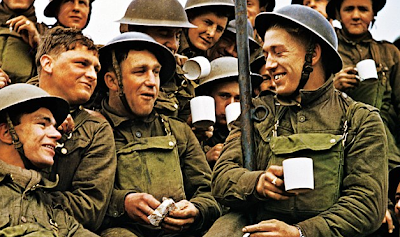 |
| Tommys taking deserved time out with a brew |
Tea houses went into a decline after WW2 with the invention of the tea bag (imported from the US in the 1940’s) but ‘getting a decent brew’ has remained a mainstay of British daily life to the present day. Indeed perhaps the most commonly used phrase in the entire British isles is ‘fancy a cuppa‘ and almost everything revolves around drinking the stuff..!!
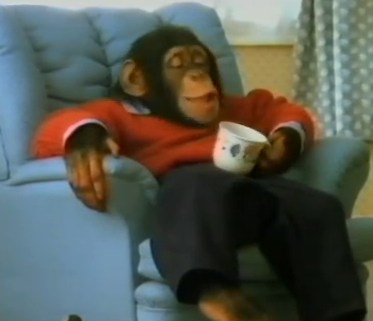 |
| PG Tips and Brooke Bond ads were monkey business… |
1. The kettle is briefly boiled and water poured into a tea pot.
2. Water is swirled around the pot to warm it and then poured out.
3. Loose tea leaves—nowadays often tea bags or the dust from a ripped-open tea bag—are then added to the pot.
4. Water is added to the pot and allowed to brew for several minutes while a tea cosy is placed on the pot to keep the tea warm. If the tea is allowed to brew for too long, i.e. more than 10 minutes, it will become “stewed”, resulting in a very bitter, astringent taste.
5. Milk may be added to the tea cup, the host asking the guest if milk is wanted, although milk may alternatively be added after the tea is poured.
6. A tea strainer, like a miniature sieve, is placed over the top of the cup and the tea poured in.
7. The straight black tea is then given to guests and they are allowed to add milk and sugar to their taste.
8. The pot will normally hold enough tea so as not to be empty after filling the cups of all the guests. If this is the case, the tea cosy is replaced after everyone has been served.
“There is also a proper manner in which to drink tea when using a cup and saucer. If one is seated at a table, the proper manner to drink tea is to raise the teacup only, placing it back into the saucer in between sips. When standing or sitting in a chair without a table, one holds the tea saucer with the off hand and the tea cup in the dominant hand. When not in use, the tea cup is placed back in the tea saucer and held in one’s lap or at waist height. In either event, the tea cup should never be held or waved in the air.
Drinking tea from the saucer (poured from the cup in order to cool it) was not uncommon at one time but is now almost universally considered a breach of etiquette.”
Recent years have seen resurgence in the British teahouse experience and taking cream tea with snacks in the afternoon is now firmly back on the English menu (not to mention the booming UK tourist trail…). The manager of the famous Black Swan tea rooms in Helmsley, North Yorkshire believes that people are returning to what they trust in harder times – “When there’s a crisis, it’s always a cup of tea that’s brought out”. The founder of Peyton and Byrnebakeries is of the opinion that “Not only is it a further nod to the craze for all things vintage, and nostalgia for Fifties domesticity, it’s one of the simplest pleasures there is”. And the range of venues offering cream tea combinations of all kinds is fairly staggering.
“Never trust a man who, when left alone in a room with a tea cozy, doesn’t try it on.”
― Billy Connolly
― Billy Connolly
The website ‘Afternoon Tea in the UK‘ gives a fairly comprehensive listing with all the old favourites like Betty’s and Taylor’s of Harrogate and the more exclusive joints mentioned above.
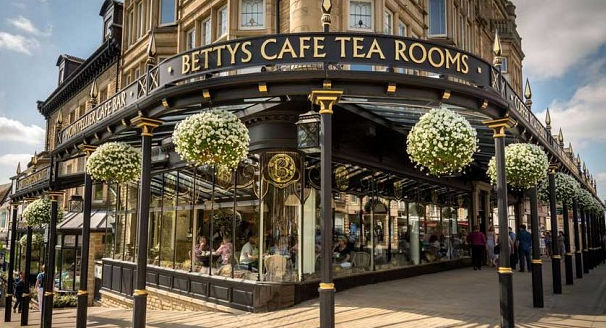 |
| Betty’s and Taylor’s, Harrogate, the temple of tea worship |
Tea time also has its place in French culture and high end tea houses have been present in Paris since the mid 19th century. However where tea became the staple drink everybody in the UK, it remained an upper class affair on this side of the channel. These days, a wide variety of teas are readily available in any French supermarket and china tea sets are not an uncommon in the average French kitchen. The niche market of high quality tea drinking has also been gaining steady ground in recent years. Kusmi and Dammann tea amongst others have taken off in a big way and fit well with the French consumer’s demand for a high quality product. There have also been an influx of luxury tea shops selling leaf tea – the Palais des Thés, Mariage Frères, Betjemen & Barton and others have an intriguing range of blends. Tea in France tends to come in subtle flavours with delicate fragrances and aromas (+ astronomical price tag…) and is about a million light-years away from the Builders rocketfuel brew we all love in the UK.
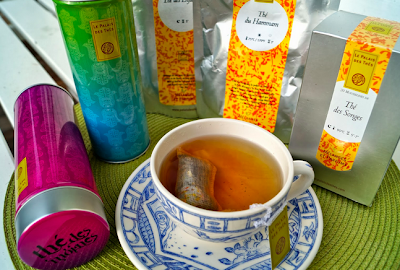 |
| A dainty French teacup and saucer xxx |
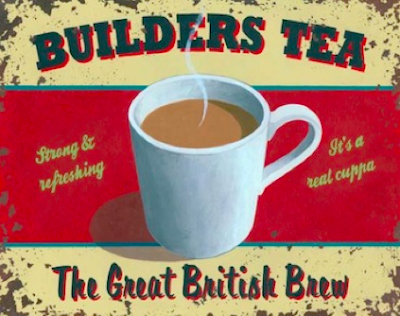 |
| A proper cuppa. |
“If the day is a sentence, tea for me is the punctuation.” – Andy
Tea time in Bordeaux..?
Compared to London the Bordeaux teahouse scene is fairly bleak. Nevertheless there are a few places which are worth hunting down.
L’autre Salon du Thé is on 11 Rue des Remparts and offers a range of teas and some delicious cakes in a cosy atmosphere. It’s definitely worth a visit although steer clear when it’s busy!
Any’Teas – with a superb location at the end of the Passage Sarget it has a terrace on Place du Chapelet in the warmer months. They claim to offer scones but I’ve not tried them…
Les Mots Bleus is at 40 Rue Poquelin Molière – neatly hidden away near Pey Berland this place has tons of comfy sofas and is a great place to read a book when it’s raining outside. Unfortunately the locals also agree which means the place often has queues.
Un Thé, etc – at 43 rue Bouffard, a chilled tea room with a large selection of muffins. Next to the Musée des Arts Décorative which also has its own tea room/café…
D’accord! – this coffee lounge next to Picard in Meriadeck 2 had a biggup review from some English geezer I found online. Earl Grey, scones and REAL imported Devonshire clotted cream all for €6.45 – the owner Constantine spent many years in the London and knows the score. Conveniently near the recently refurbished Connemara which now also does tea and cake.
La Diplomate, 32 rue du Parlement St Pierre has a unique atmosphere and a range or exciting tea blends.
Un Thé, etc – at 43 rue Bouffard, a chilled tea room with a large selection of muffins. Next to the Musée des Arts Décorative which also has its own tea room/café…
D’accord! – this coffee lounge next to Picard in Meriadeck 2 had a biggup review from some English geezer I found online. Earl Grey, scones and REAL imported Devonshire clotted cream all for €6.45 – the owner Constantine spent many years in the London and knows the score. Conveniently near the recently refurbished Connemara which now also does tea and cake.
La Diplomate, 32 rue du Parlement St Pierre has a unique atmosphere and a range or exciting tea blends.
L’Orangérie at the Jardin Public – Refurbished last year it’s a bit pricey but is one of Bordeaux’s best summer cafés with a giant terrace by the park and sun loungers. Tea and cake is on offer as well as awesome ice cream – incidentally pints of freezing cold lager are also available to take away…
The Grand Hotel has an afternoon tea on offer for the giveaway price of €35pp. However the fact that they call it ‘So British’ instantly has alarm bells ringing.
This link gives some other addresses via FB to check out…
For any accessories such as china teasets, tea cosies, marmelades and other cat related goodies look no further than the Tea Cosy English ’boutique’. It’s at number 60 on the newly pedestrianised Rue Bouffard opposite the Un Thé, etc….
The Grand Hotel has an afternoon tea on offer for the giveaway price of €35pp. However the fact that they call it ‘So British’ instantly has alarm bells ringing.
This link gives some other addresses via FB to check out…
For any accessories such as china teasets, tea cosies, marmelades and other cat related goodies look no further than the Tea Cosy English ’boutique’. It’s at number 60 on the newly pedestrianised Rue Bouffard opposite the Un Thé, etc….
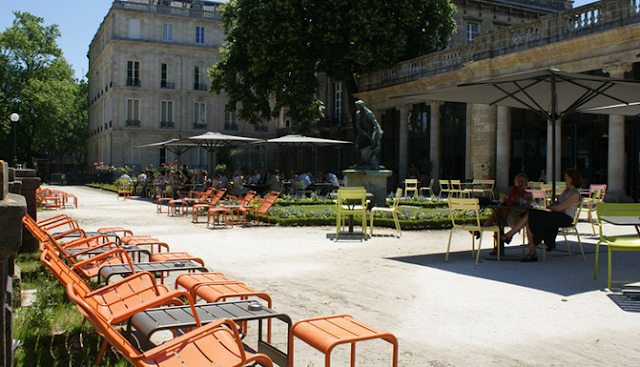 |
| Sun loungers @the Orangerie, Jardin Public – genius |
The English Country Kitchen
Opening its doors in mid-January, this truly English teahouse is a brand new concept for Bordeaux. I caught up with Arthur, the manager for a brief interview:
Where did the idea of the ECK come from?
The ECK is a concept that we imagined following our experience of building English Pubs in France. Indeed, we have a few pubs in France and we are always trying our best to give a Real Taste of England.
The ECK is a concept that we imagined following our experience of building English Pubs in France. Indeed, we have a few pubs in France and we are always trying our best to give a Real Taste of England.
We then thought that there definitely was a demand for some Englishness here in France and it is for sure that a real English tea room/country kitchen is a big part of the culture in the UK. This is how it all started.
Have you based the concept on existing café/bistros in the UK, US or France? – for example, Jamie Oliver’s new Italian cafés in the UK…
We definitely base ourselves on some existing country kitchens from the UK and we try to bring our knowledge of the French market into the concept whilst keeping as English as possible.
Have you much experience running Anglo-centric businesses in France or elsewhere?
I have been running English pubs here in France for 3 years and I used to work in England in different types of restaurants/bars before that. The English culture of the hospitality industry is really becoming popular here in France and I can see the market growing.
How closely connected are you to the rest of the Charles Wells group? – will you be running any promotions with the SH and CD for example?
We definitely are connected as we are part of the same company and are managed by the same people.
However, there is no plan at the minute to be creating promotions or events with our pubs as we think that they do not necessarily attract the same customers and we do not offer the same thing.
Also, the plan is to develop the ECK concept and so before we do that, we want to make sure that this definitely can work by itself without using too much of the existing pub trade and customers.
Also, the plan is to develop the ECK concept and so before we do that, we want to make sure that this definitely can work by itself without using too much of the existing pub trade and customers.
Are you connected to any Expat groups or businesses in Bordeaux?
We are not so far but we definitely would like to as I think both sides could benefit. This will allow us to ensure we keep our Englishness by listening to our Anglo-customers.
Do you plan to branch out elsewhere in Bordeaux or to other French cities?
There is definitely a plan for it in the next few years but nothing concrete at the moment.
How do you feel about the future development of Bordeaux (new stadium, luxury river cruises, LGV, etc.) particularly as an Expat destination?
I feel that Bordeaux is definitely becoming a really attractive pole here in France for anyone. English people living in French cities (as opposed to countryside) have most likely come over for work. This means that with the LGV etc… Bordeaux will attract businesses to set foot or settle in Bordeaux as opposed to other cities, in particular Paris, and this will automatically bring more expats here.
I feel that Bordeaux is definitely becoming a really attractive pole here in France for anyone. English people living in French cities (as opposed to countryside) have most likely come over for work. This means that with the LGV etc… Bordeaux will attract businesses to set foot or settle in Bordeaux as opposed to other cities, in particular Paris, and this will automatically bring more expats here.
Do you have anything further to add?
I would like to take this opportunity to thank you for this interview and to invite any Anglo-expats in Bordeaux to come and experience the English Country kitchen. A little corner of England in the center of Bordeaux!
The Review
Having lived in France for about 10 years I have come to expect the unexpected when dealing with the froggies and to be honest we were blown away. The ECK was apparently created by the owner of the Charles Wells group so that he could have his own personal tea room when visiting Bordeaux and no expense has been spared. They brought in the designer who’s worked on all their pubs and the attention to detail is astonishing.
From the massive collection of Anglo-nostalgic memorabilia (where did they find all this gear?) such as the milk churns, tea chests, giant Victorian cast iron radiators, ceramic fireplace with oak mantelpiece, wooden tables/chairs and floor, AGA oven (hollowed out…) to the evocative framed pictures and tea posters they have created a unique atmosphere that will instantly transport you to the heart of the Cotswolds… Add to this the 1950’s music rolling out of old style radios in the background, the Betty’s teapots, rustic handwritten blackboards the look of the tea room is more than convincing.
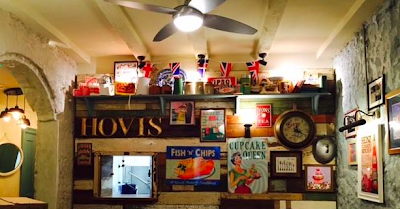 |
| The Hovis TV ad from 1973 is a big British favourite |
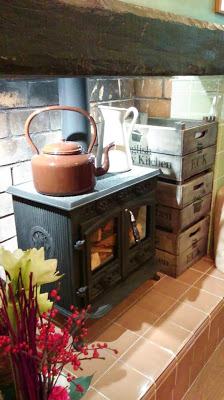 |
| The Brown Betty! |
However, the Anglo Saxon customer is a discerning breed, especially when it comes to something being sold as truly ‘English’…And the ECK goes the extra mile when it comes to authenticity and has been infused with all the more intangible aspects of being British. Lyles Golden Syrup, HP Sauce and Sarsons vinegar on the tables, Jamie Oliver (love or loathe the fat-tongued ****) and Hairy Bikers books on the counter, Daily Mail, and a decent range of English beers WITH pint glasses available – they all do the business.
It is also clear that the place has been designed by someone with considerable café/restaurant experience. There are laptop friendly tables around the walls (complete with numerous high plug sockets), high stools and coat hooks. Another plus for those with babies in giant push chairs (i.e. us) is that there is more than enough room to park. They have a lounge seating areas and tables for small or large groups.
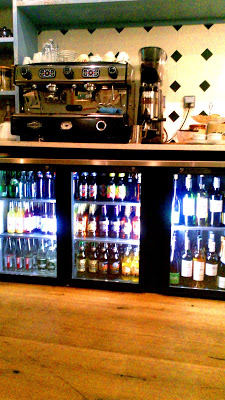 |
| A fridge full of British beers (incl. Double Choc Stout – centre) |
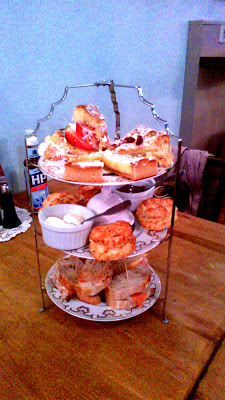 |
| A King’s ransom |
On to the service and food/drink…
To start with, everyone speaks fluent English and one of the waitresses is English. They were all swift, attentive and friendly. Secondly are the gargantuan portions: at €16 for two for afternoon tea we had the triple decker tea rack with a sandwich, scone and cake ensemble and giant pot of tea which left us struggling for breath by the end. The scones came in two varieties (one salty with onion) and the clotted cream/jam was rich and copious. The sandwiches (smoked salmon/cucumber & cheese/ham) took the edge off all remaining afternoon hunger and the cake was the ultimate finale with a choice of strawberry, lemon meringue and frangipane (almond paste cake similar to marzipane)
On to the tea… they stock the Tea Pig brand – an alternative high quality trendy UK company which was launched in 2006. We opted for Darjeeling which was refreshing and the pot gave us about three cups each which was more than enough. There is an ample selection with Everyday brew or Lemon and Ginger also on offer. The crockery was real English bone china as well which added to the experience.
All those around us seemed very content with their meals, whether they were taking afternoon tea or some of the other delights on offer. Next time we go we can work down the list. Other food options include: Soups, Pies, English salad, Chicken Caesar salad and Goat cheese and apple salad. See the menu for more details.
The Bordeaux Expat verdict: HIGHLY RECOMMENDED!!!
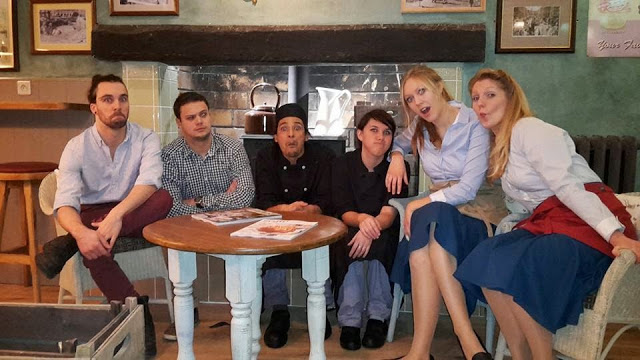 |
| The staff of the ECK striking a pose… |
If you wanna read more about tea, have a look at the some of the books below.
Another blog about the ECK in French is here.
To hear a song about tea, here is the Kinks performing ‘Have a Cuppa Tea’ in 1971: https://www.youtube.com/watch?v=lw6qxDPmOGM
Another blog about the ECK in French is here.
To hear a song about tea, here is the Kinks performing ‘Have a Cuppa Tea’ in 1971: https://www.youtube.com/watch?v=lw6qxDPmOGM
For a classic French cliché of British tea here is the ‘Tea for Two’ scene from La Grande Vadrouille with Bourvil/de Funès: https://www.youtube.com/watch?v=R-VIW94KPy4
And here’s Ella’s version of ‘Tea for Two’: https://www.youtube.com/watch?v=z7kfiA2SXMY
Finally… the BBC on Clotted Cream and Tea parties
– TTFN and having mentioned the word ‘tea’ 156 times we’re now off for a cuppa in the English tea house in Sandakan, Borneo…
Bibliography
· Anonymous (‘A Gentleman of Cambridge’), A Treatise on the inherent qualities of the tea
herb… (First ed. London, 1750; facsimile reprint, St Peter Port, 1978)
herb… (First ed. London, 1750; facsimile reprint, St Peter Port, 1978)
· Anonymous, The Good and Bad Effects of Tea consider’d… (London, 1758)
· Andrew Barr, Drink, A Social History (London, 1995).
· Charles Dickens, Great Expectations (Everyman edition, London, 1994).
· Charles Dickens, The Adventures of Oliver Twist (Everyman edition, London, 1994).
· Carolyn Caldicott, Vintage Tea Party, 2012
· Susan Cohen, London’s Afternoon Teas: A Guide to London’s Most Stylish and Exquisite Tea Venues
· Dr Duncan, Wholesome advice against the abuse of hot liquors particularly of coffee, chocolate, tea, brandy and strong waters (London, 1706).
· Dubrin, Beverly (2010). Tea Culture: History, Traditions, Celebrations, Recipes & More. Charlesbridge Publishing
· The Etiquette of Modern Society (London, 1881).
· Mary E. Farrell, From Cha to Tea, A Study of the Influence of Tea Drinking on British Culture (Universitat Jaume I, 2002)
· Elizabeth Fellow, Tea at Downton: Afternoon Tea Recipes From The Unofficial Guide to Downton AbbeyPaperback, 2014
· Denys Forrest, Tea for the British (London, 1973).
· Jonas Hanway, An Essay on Tea, considered as pernicious to health, obstructing industry and impoverishing the nation… (London, 1757).
· Dorothea Johnson, Tea & Etiquette: Taking Tea for Business and Pleasure (Capital Lifestyles) Paperback – August 1, 2000
· Samuel Johnson, Review of Jonas Hanway’s ‘An Essay on Tea…appended to A Journal of Eight Days Journey, in The Literary Magazine, XIII, May 1757 (facsimile reprint of The Literary Magazine, vol. II, with introductory notes by Donald D. Eddy, New York, 1978).
· Emma Marsden, Tea at Fortnum and Mason, 2010
· Roy Moxham, Tea, Addiction, Exploitation and Empire (London, 2003).
· George Orwell, Keep the Aspidistra Flying (new ed., London, 1997).
· George Orwell, The Collected Essays, Letters and Journalism of George Orwell, edited by Sonia Orwell and Ian Ang (London, 1970)
· Jane Pettigrew & Bruce Richardson – A Social History of Tea, Benjamin Press, 2013
· Helen Simpson, The London Ritz Book of Afternoon Tea –1986
Related posts
This template supports the sidebar's widgets. Add one or use Full Width layout.

